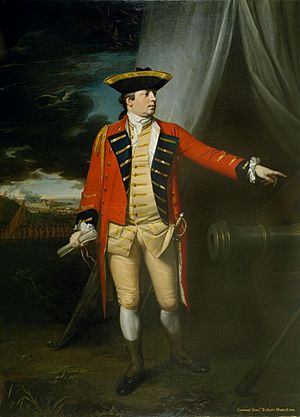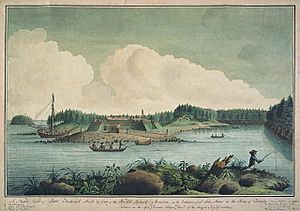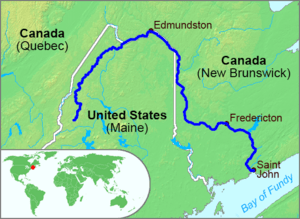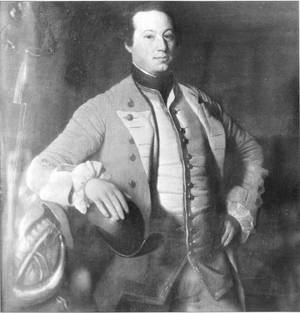St. John River campaign facts for kids
Quick facts for kids Saint John River campaign |
|||||||
|---|---|---|---|---|---|---|---|
| Part of French and Indian War | |||||||
 Robert Monckton, British commander in the Saint John River campaign |
|||||||
|
|||||||
| Commanders and leaders | |||||||
|
|
||||||
| Units involved | |||||||
| Acadia militia Wabanaki Confederacy (Maliseet militia and Mi'kmaq militia) |
|||||||
The Saint John River campaign was an important event during the French and Indian War. In late 1758, British Colonel Robert Monckton led about 1150 soldiers. Their goal was to destroy Acadian villages along the Saint John River.
The British force included Captain George Scott and New England Rangers. These rangers were special soldiers skilled in wilderness fighting. They were led by Joseph Goreham, Captain Benoni Danks, William Stark, and Moses Hazen.
Under naval commander Silvanus Cobb, the British started at the river's mouth. They attacked areas like Kennebecasis and Managoueche (now part of Saint John City). Here, the British built Fort Frederick. They then moved upriver, attacking Grimross (Gagetown, New Brunswick), Jemseg, and finally Sainte-Anne des Pays-Bas (today's Fredericton, New Brunswick).
The Acadian fighters were led by French officer Charles Deschamps de Boishébert et de Raffetot and Acadian Joseph Godin dit Bellefontaine. About 100 Acadian families lived along the Saint John River, many of whom had moved there to escape earlier forced removals. Around 1000 Maliseet people also lived in the area.
This campaign was part of a larger British effort in 1758. They also targeted other Acadian areas like Ile Saint-Jean, the Gulf of St. Lawrence, Cape Sable, and the Petitcodiac River campaign.
Contents
Why the Campaign Happened
The British took control of Acadia in 1710 after the Conquest of Acadia. For the next 45 years, the Acadians refused to promise full loyalty to Britain. They often helped the French and fought against the British. They also supplied the French forts like Louisbourg and Beausejour.
During the French and Indian War, the British wanted to stop the Acadians from helping the French. They also wanted to cut off the supply lines to Louisbourg. So, the British decided to remove Acadians from the area.

Acadians had lived in the Saint John River valley for a long time. After the British conquest in 1710, many Acadians moved from Nova Scotia to the French-controlled Saint John River. These Acadians were known for strongly resisting British rule.
The people living along the Saint John River were very good at fighting off the British. The Maliseet militia and the Mi'kmaq militia often fought against New England forces. In 1748, Acadians and Mi'kmaq stopped British officer John Gorham from getting them to swear loyalty.
In 1749, French officer Boishebert built Fort Boishebert near the river's mouth. This fort was later abandoned, and the French built Fort Menagoueche there instead. Boishebert also put Acadian Joseph Godin dit Bellefontaine in charge of the Acadian fighters in the Saint John area.
In 1755, British Captain Cobb found a French ship carrying war supplies for Boishebert. The British captured the ship and took it to Halifax.
After the Battle of Fort Beauséjour in 1755, Robert Monckton sent troops to take Fort Menagoueche. Boishebert burned the fort himself to prevent the British from using it. However, he continued to control the river using guerrilla warfare.
The British began removing Acadians in 1755. The Saint John River valley became a key place for Acadian and Wabanaki Confederacy resistance. Boishebert was a main leader of this resistance. He ordered attacks like the Raid on Lunenburg (1756) and the Battle of Petitcodiac (1755).
After the Siege of Louisbourg (1758), more Acadians were forced to leave their homes. Many fled to villages along the Saint John River, like Grimross and Sainte-Anne des Pays-Bas.
Building Fort Frederick
On September 13, 1758, Monckton and his strong force of soldiers and rangers left Halifax. They arrived at the mouth of the Saint John River a week later. Although Fort Menagoueche had been destroyed, some local fighters shot at the British and then fled upriver.
Monckton decided to build a new base. He rebuilt Fort Menagoueche and renamed it Fort Frederick. This new fort helped the British cut off supplies and communication to the Acadian villages upriver.
When Monckton's troops appeared, Boishebert retreated. This left the Acadian villages like Grimross, Jemseg, and Sainte-Anne des Pays-Bas largely unprotected. Boishebert told Acadians to go to Quebec City. However, many Acadian fighters, led by Major Joseph Godin, chose to stay and defend their lands at Ste-Anne.
The Campaign Attacks
Attack on Grimross

On October 1, Monckton left Fort Frederick with his boats, soldiers, and rangers. Two days later, they reached the village of Grimross. About 50 families had moved there in 1755. They were forced to leave their homes.
Monckton's troops burned every building in the village. They also set fire to the fields and killed all the farm animals.
Attack on Jemseg
Two days after Grimross, Monckton arrived at the village of Jemseg, New Brunswick. His troops burned this village to the ground as well. After that, he returned to Fort Frederick at the mouth of the Saint John River.
Attack on Sainte-Anne des Pays-Bas
Monckton did not continue to Sainte-Anne des Pays-Bas (now Fredericton, New Brunswick) right away. Winter was coming, and he was worried about being stuck by the frozen river. He turned back at Maugerville and sailed to Halifax with 30 Acadian families as prisoners. Major Robert Morris was left in charge of Fort Frederick.
Almost three months later, in February 1759, Monckton sent Captain John McCurdy and his rangers to Ste. Anne's Point. They traveled on snowshoes. Captain McCurdy died in an accident, and Lieutenant Moses Hazen took over. When the Acadians realized the British were coming, most of them went to the Maliseet village at Aukpaque for safety.
On February 18, 1759, Lieutenant Hazen and 22 men arrived at Sainte-Anne des Pays-Bas. They destroyed and burned 147 buildings, including two churches and all the barns and stables. They also burned a large storehouse filled with hay, wheat, and other supplies. They killed many horses, cattle, and hogs. Only a few Acadians were found, as most had already fled north with their families.
In February 1759, Acadian leader Joseph Godin dit Bellefontaine and his group of Acadians tried to ambush the rangers. However, Hazen's rangers eventually captured Godin and his group. Godin refused to promise loyalty to the British. The rangers took six prisoners during this attack. Godin was known for encouraging the Indigenous people to fight against the English. He was taken prisoner and eventually sent to England and then to France.
Godin later stated that he was a major of the Saint John River Militia. He also shared that he witnessed terrible events during his capture. He and his wife spent the rest of their lives in Cherbourg, France. General Amherst was displeased with Hazen's actions during this capture.
On April 22, 1759, the Acadian militia captured a ranger outside Fort Frederick. On May 18, 1759, soldiers fishing outside the fort were attacked by Indigenous warriors. One soldier was taken. On June 15, 1759, another group of soldiers fishing was ambushed by Acadians and Indigenous fighters. One soldier was killed, and another was badly hurt.
The British at Fort Frederick were not sure if the village was completely destroyed. They sent at least three more trips upriver to Ste Anne between July and September 1759. The soldiers captured some Acadians, burned their homes, destroyed their crops, and killed their cattle. The September trip involved over 90 men. On September 8, at present-day French Lake, the Acadian militia ambushed the British rangers. This fight resulted in at least 9 rangers killed and three badly wounded.
What Happened After
The British campaign destroyed the Acadians' supplies, causing many to suffer from hunger. Canada's Governor Vaudreuil reported that 1600 Acadians moved to Québec City in 1759. That winter, Quebec also faced hunger, and a smallpox sickness spread, killing over 300 Acadian refugees. Some Acadians returned to Saint John but were then imprisoned on Georges Island in Halifax Harbour.
In the spring of 1759, 29 refugees from the Saint John River area moved further up the St. Lawrence River. They successfully started a new community near Bécancour, Quebec.
After the fall of Quebec on September 18, 1759, the resistance ended. The Maliseet and Acadians of the Saint John River surrendered to the British at Fort Frederick and Fort Cumberland. On January 2, 1760, most of the Acadian men who came to Fort Frederick were put on ships. The next day, the women and children were also boarded, and the ships sailed for Halifax. Within weeks, these captured Acadians were sent to France.
In 1761, there were still 42 Acadians at St Ann and 10–12 at Grimross. In 1762, Lieutenant Gilfred Studholme tried to remove the remaining Acadians from the Saint John River. This was to make way for new settlers from New England. However, he was not successful. After the Seven Years' War ended in the 1760s, many Acadians returned to the river valley and other parts of what is now New Brunswick. This region then became a main center for Acadian life in the maritime area.




